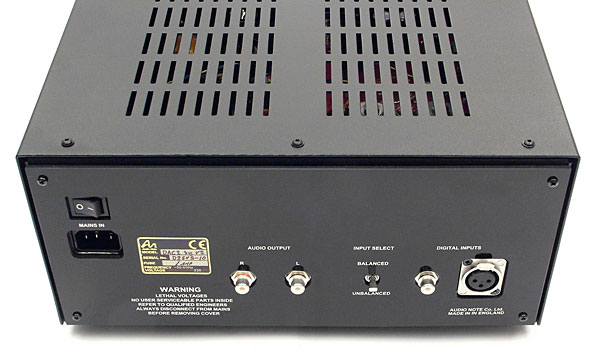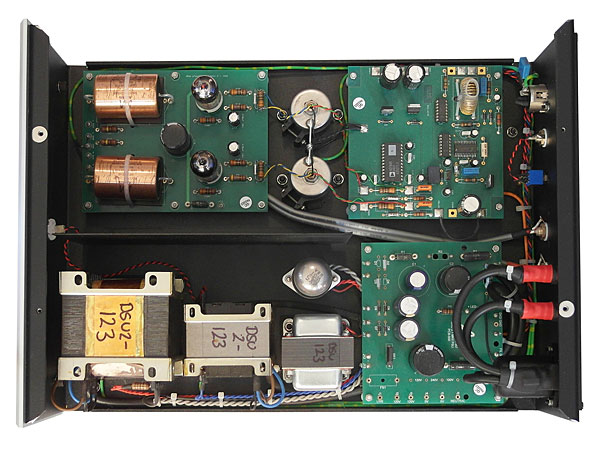| Columns Retired Columns & Blogs |
Can't see why someone would spend this kind of money on a CD player that can't even play hi-res formats like SACD. What were they thinking?
In a similar vein, the combination of CDT One/II and DAC 2.1x Signature produced greater-than-average levels of what Herb Reichert calls "flesh and blood." With "Weight of Love," from the Black Keys' Turn Blue (CD, Nonesuch 7559-795554), the sound of the Audio Notes was distinguished by much greater heft and substance, and a larger sense of scale, than that of my Sony player: The British two-boxer sounded, quite simply, meatier: The stiffly played acoustic guitar that kicks off this number's long, "Down by the River"–like introduction was more timbrally rich and real through the Audio Notes, and the drums—what a great sound Patrick Carney gets!—didn't have the same huge, reverberant, verge-of-chaos sound when I played this CD in the Sony. Even the Audio Notes' spatial performance was superior—or, at least, more to my taste: Within that invitingly large soundfield, Dan Auerbach's lead vocal was solidly anchored at center stage, but set back just a bit from everything else—the latter distinction not quite as evident through the SCD-777.
But there was even more to the distinction: When played through the Audio Note CDT One/II and DAC 2.1x Signature, "Weight of Love" was simply more compelling, exerting a tighter grip on my attention. I came back to this track for a later comparison, switching up the playing order to make certain the above conclusions hadn't been simply a matter of listener fatigue; the Audio Notes endured as the more involving gear.

My appetite for spacey electric guitar unsated, I followed up with the title track of Robin Trower's Bridge of Sighs (CD, Chrysalis/Mobile Fidelity Sound Lab UDCD 684), which I hadn't heard in years. Those years had not been kind to the music—Trower was and is a fine guitarist, but the humorlessness of the lyrics, and of the late James Dewar's lead vocal, were a drag on my efforts to rekindle any long-dormant enthusiasm—and the sound of this recording was, through both CD players, bassless and small. Was the Audio Note duo a bit richer in timbre, and more revealing of what little nuance could be gleaned from that standard-issue bloozey vocal? It seemed so—but the distinction didn't seem to be of much consequence. (CD for sale!)
Now that my RotoVibe ticket had been punched, I moved on to solo-piano music, beginning with a favorite collection of Chopin Waltzes, Mazurkas, and other pieces, performed by Witold Malcuzynski (CD, EMI 5 68226 2). Listening to the Waltz No.3 in a, Op.34 No.2, I was impressed by the Audio Notes' musicality—their ability to convey subtle variations in tempo and intensity and to play lines of notes with their momentum and flow intact. The first thing that came to mind was that some notes in the left hand were so timbrally complex that they seemed freighted with an excess of texture: the sound wasn't buzzy or fuzzy, but it skated right up to the border of same, and I found myself wishing for a little more fundamental and a little less overtone. I checked this impression with an AIFF file ripped from the same CD, played through the Halide DAC HD—itself noted for being slightly on the timbrally rich side—and confirmed that the computer-audio rig offered a clearer sound on those left-hand notes. That said, I ultimately found the Audio Note combination to be more musically compelling. The many modulations in the Waltz No.8 in A-flat, Op.64 No.3, notably the extended passage in C, made more sense when I listened to this CD through the Audio Notes.
Not long after that, I found myself in the mood to hear some selections from the 2001 reissue of George Harrison's masterpiece, All Things Must Pass (2 CDs, Gnome/EMI CDP 30474 2): a wretched-sounding remastering by Jon Astley, and cursed with a foolish and ill-advised reimagining of the original's austere cover art (not that I have an opinion on the matter). The harsh highs were, if anything, a little more grating through the Audio Notes than I heard from CD rips of the album played from my Apple iMac through my Halide DAC HD processor. It dawned on me: As good as the Audio Notes were at bringing out the goodness of good recordings, they also had a knack for accentuating the badness of certain types of bad recordings. Which is to say: The CDT One/II and DAC 2.1x Signature spent most of their time shouting the truth, not whispering pretty lies.

From there on, I decided to focus only on good CDs. (Where do I get these ideas?) Compared with my Sony SCD-777, the Audio Notes made the horns in Bruckner's Symphony 5, performed by Lovro von Matacic and the Czech Philharmonic (CD, JVC JM-XR24203), so much more listenable that the difference made me laugh out loud. Through the British combo, the brasses in the first movement were richly colored and realistically blatty—but the latter quality didn't come at the expense of my nervous system, as is usually the case. The Eroica Quartet's recording of Mendelssohn's String Quartet 2 (CD, Harmonia Mundi HMU 907245) had sensationally good touch and tone, and the Audio Notes allowed the quartet a much larger sense of scale than did an AIFF file ripped from the same CD and played through my computer-music system.
My best experience with the Audio Note duo? I can narrow it down to two. First was when I played the Beatles' The Complete Rooftop Concert (Yellow Dog YDCD015), a bootleg from a now-defunct Italian label that contains every moment of audio from the group's famously impromptu live performance of January 30, 1969. The recording begins in medias res—a jumble of incidental sounds and unidentified voices (the first voice one hears is that of a technician shouting "All cameras live!")—and although it's a bit rough, through good gear it succeeds in putting across a mood of excitement and jubilation. The Audio Notes let me hear it that way better than any other digital source component I've tried.
The other pinnacle: the sounds of John Coltrane's tenor saxophone and Wilbur Ware's double bass—and, of course, Thelonious Monk's piano—in "Monk's Mood," from Thelonious Himself (CD, Riverside/JVC VICJ-60170). That bass had such a believable sense of touch, especially from Ware's second entrance to the end; and the presence of Coltrane's sax, front and center, was spellbinding: tons of tone, all around.
Conclusions
I don't know what John Atkinson will find when he measures the Audio Notes' performance, but I can make a good guess. My previous experience with the company's digital source components suggests that the DAC 2.1x Signature, in particular, may generate distortion products of which other, more technologically up-to-date digital products are comparatively free.
I would also guess that Audio Note will take this in stride. They make no secret of the fact that their approach to digital audio is technologically out of step with almost everyone else's—or of their belief that their approach results in products of superior musicality, whatever else they do or don't accomplish.
The question of whether the sound of the Audio Notes should be praised as being true to the essence of music, or blamed for trading in pleasing distortions, will never be answered to the satisfaction of all—at least not in a 2800-word product review. What I can say for sure is that the musical strengths of the CDT One/II CD transport and DAC 2.1x Signature DAC are incontrovertible: With the possible exceptions of the mighty Naim CD555 and Audio Note's own CD-4.1x, I have never heard a CD player that beats this combination in the ability to involve me in the magic of notes and rhythms, or that presents lines of notes in such a musical and attention-grabbing manner. Vigorously recommended.

Can't see why someone would spend this kind of money on a CD player that can't even play hi-res formats like SACD. What were they thinking?

Wait! NO USB?!? Sacrilege! This will require additional effort!!!
Someone purchasing this unit will have a huge cd collection, and want those discs to sound like only AN gear can. Given the likelihood that same collector probably has 1/20 as many SACD recordings, the 'oversight' is understandable.
It's like a mono-only turntable rig- audiophiles want and need greatness, and they are willing to pay for it- even if it sacrifices functionality in other areas. If they have to buy another dedicated turntable system for stereo discs, they do it. Compromises are made in every decision humans make.

Thanks! for sharing- AD. As a believer in both CD and SACD, these formats are not going away anytime soon. Second, it was okay reading about a former statement spinner (Sony ES) compared to this newer one in your review. No doubt that the Sony's DAC is old in comparison.

With a hypothetical 1000 CD library several are likely to be SACD. And once these are played on a good SACD transport I'm sure more would be added to collection. Hence, I strongly agree with the comment indicating that a product at this price point should not have SACD capability is ridiculous especially for someone listening to classical music, which is not the case with the Stereophile reviewer here -a Chopin waltz doesn't cut it.

This is probably the worst measured performance I´ve ever seen.
Experience tells me, that this will beyond any reasonable doubt, be recognised in the musical performance.
My goodness this is bad.

You'll find much worse measured performance on some parameters on at least 3 other devices reviews on this site check out
http://www.stereophile.com/content/lector-strumenti-audio-digitube-s-192-da-converter-measurements#EQ4S4D26TjZCfsjk.97
for starters